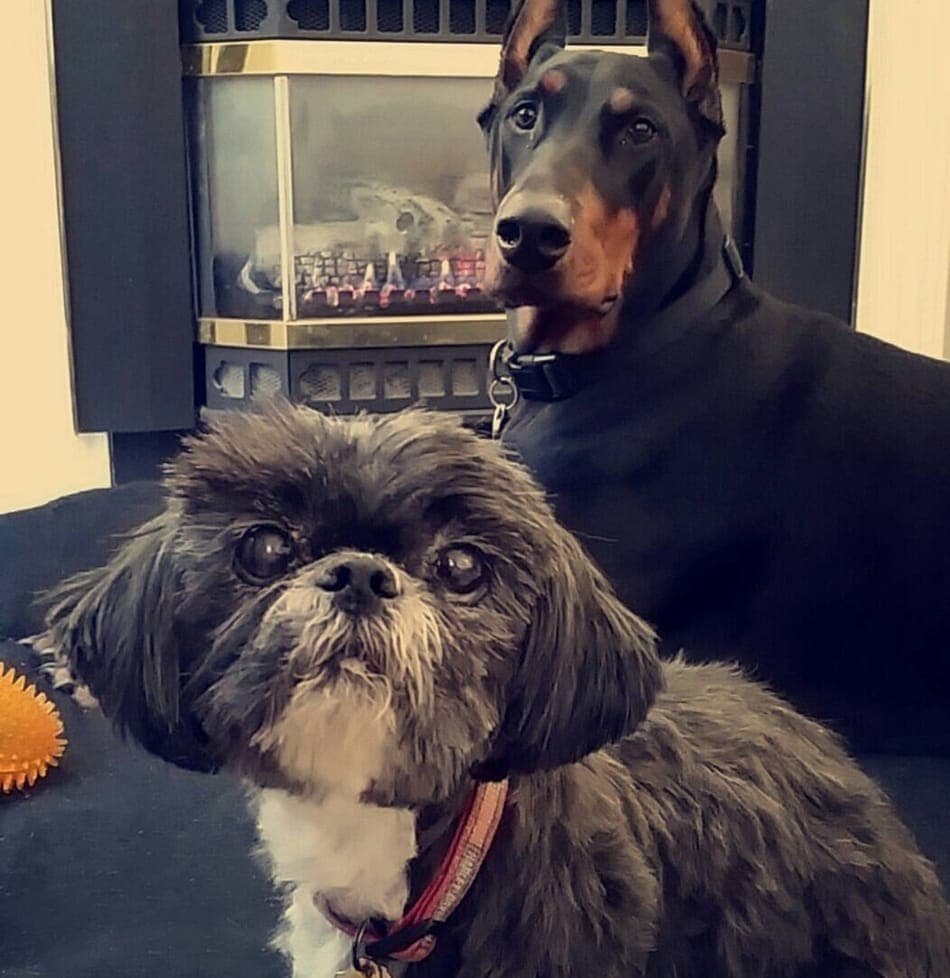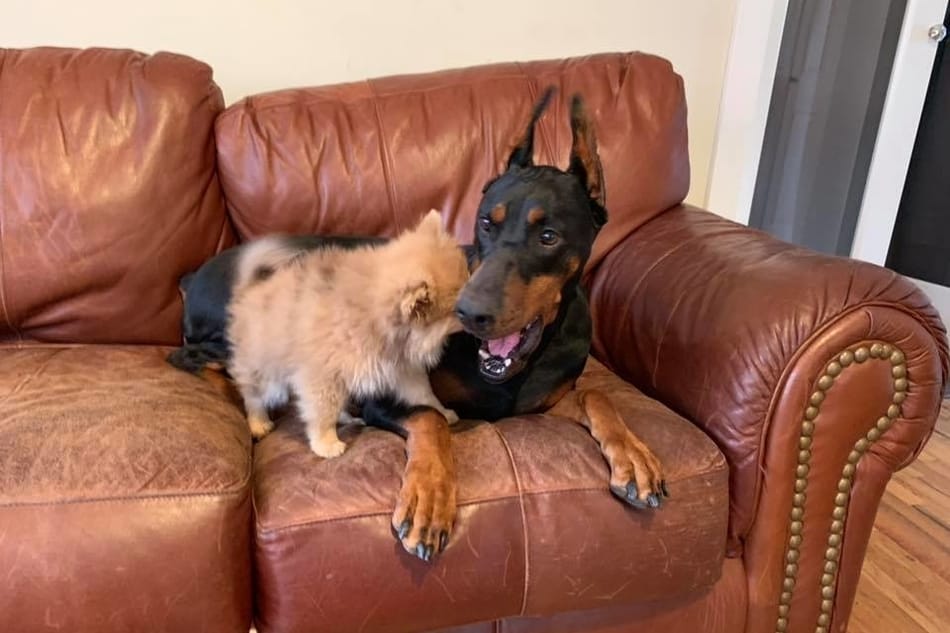
Doberman Pinschers are large, powerful dogs and it makes sense that those considering bringing one into a home with small dogs present might be more than a little concerned. I’ve had personal experience with this, and have also talked to countless other Doberman owners in the same situation and there are a few things you need to be aware of before trying this.
Can Dobermans get along with small dogs? A Doberman that has been well socialized from a young age is likely to get along well with most small dogs. However, problems can occur when the Doberman is not well socialized, when both dogs are unneutered males, or during interactions involving food.
Without taking some basic steps, there is certainly potential for disaster when it comes to pairing a small breed of dog (Pomeranian, Shih Tzu, Pug, Miniature Pinscher, Toy Poodle, etc) in a home with a Doberman. Something as simple as a minor corrective swipe with a paw, nip, or unexpected rollover from your Doberman can literally be deadly to a small dog whereas if it were done to a dog of similar size, it would be a minor incident at best.
Dobermans Living with Small Breeds
Although Dobermans are generally kind dogs with a friendly demeanor, they can certainly have some issues sharing a home with a small breed of dog. Most of these issues are not the result of purposeful actions by the dogs, but accidental in nature.
Yes, Dobermans can do exceptionally well with small dogs living in the same home as them. Dobermans are intelligent, gentle dogs who are easily trainable and have a strong desire to please their owners. These are all attributes that can work greatly in your favor when trying to guide them into a successful relationship with another dog.
That’s why so many Doberman owners have no problem also having smaller, more fragile, breeds of dog sharing the same household. You just need to provide that guidance and make sure they know what’s expected of them (i.e. gentle interactions with the other dog in the house).
So what’s the difference between those who succeed in having a Doberman and small dog living in the same house and those who fail? It’s the little things. There are a few simple things that you can do to help make sure your Doberman gets along with your small dog that really does have a huge effect on the outcome. So after talking to countless owners who have both small dogs and Dobermans in the same house, I’ve narrowed the best advice down to the following most important tips.
HINT: If you’re curious about how Dobermans are with cats, see my article Can Dobermans Get Along with Cats? Making Introductions. Even if you’re dealing with a small dog, a lot of the advice in that article can help you understand what an ideal introduction between animals looks like.
Small Dogs That Are Doberman Compatible
There are many small dog breeds that owners have living together quite successfully in their home along with their Doberman.
Please note that this is not a complete list. Many breeds not listed here likely will get along great with a Doberman. This list was compiled by my own non-scientific methods of speaking to owners of Dobermans who also have small dogs.
Those with smaller dog breeds who have found success pairing them in a home with a Doberman, went on this list. Below are some of the breeds I’ve found to be successful with Dobermans in the past.
- Miniature Pinscher (Min Pin)
- Border Terrier
- Pomeranian
- Jack Russell Terrier
- Dachshund
- Cocker Spaniel
- Chihuahua
- French Bulldog
- English Bulldog
- Pug
- Toy Poodle
- Shih Tzu
- Beagle
Every dog has its own individual temperament, so it’s really more important to match temperaments than it is to choose certain breeds. I wrote an article all about how to perform temperament tests on Doberman puppies which outlines how to pick a puppy with an ideal temperament.
Tip #1: Get Dogs of the Opposite Sex
Dogs of the opposite sex get along worlds better than dogs of the same sex. If you must get dogs of the same sex, try to get two females with a good age gap in between them. Two male dogs tend to have a much more difficult time getting along.
Two males will likely have issues due to their natural instincts to assert their dominance in the house. It probably won’t be a problem when one is a puppy, but as soon as that puppy matures, and they have a disagreement over food, you could have a big problem on your hands.
Tip #2: Space out Their Ages by at Least 2 Years
It’s been shown time and time again that dogs who have an age difference between them get along much better than dogs who are the same age. If there is at least a two year age difference between your small dog and your Doberman, then you stand a good chance of having them get along.
Ideally, it’s best if the small dog is the older one and is already established in the house before getting a Doberman puppy. This is because Doberman puppies are far more likely to express playful curiosity at a young age towards another dog than any kind of aggression. So if your small dog is mature, and your Doberman is immature (and physically small due to their young age), you’re likely to have positive interactions between the two. Just be extra cautious around the time the Doberman is just starting to get large in size but is still a playful puppy at heart—lots of injuries happen around then.
Lastly, a more mature smaller dog will know when things are getting too rough and how to “stay out of the way” of a bigger dog. If you have an adult Doberman and get a puppy of a smaller breed, they will likely not know when or how to get out of the way of the bigger dog and injuries are much more likely.

Tip #3: Neuter the Males
Neutered (or fixed) males are much more docile and have less of those pesky male hormones running their emotions. They are likely to be less forceful about asserting dominance in the house over your other dogs, and fewer problems will occur as a result.
The younger the dogs are neutered, the better off you are. If you wait until your Doberman has already reached adulthood (about 2 years of age), then neutering won’t be near as effective in suppressing some of that natural dominant behavior.
Tip #4: Keep Them Separate at Feeding Time
Statistically, most dog bites happen during or near feeding time. Dogs are wild animals at heart, and in the wild, they have to protect their food scraps from scavengers. That’s why they naturally have the instinct to be extra protective and even aggressive, with other animals around feeding time.
If, for example, your small dog gets too close to your Doberman when he’s eating, it wouldn’t be unlikely for the Doberman to scold the smaller dog with a nip, or worse. With a dog of the same stature as a Doberman, this would be no big issue. But for a small dog, this could literally be deadly.
Tip #5: Train Your Doberman to “Leave It”
Make sure your Dobie has a good handle on the “leave it” command before attempting to introduce him to a small dog. Dobermans are natural predators, especially of small furry animals. That’s why he could easily mistake your new Pomeranian or Chihuahua for something that needs to be pursued and hunted.
So having an established command that your Doberman has practiced and shown proficiency in, which would signal for him to walk away from the dog, can be a lifesaver. During the early meetings between the two dogs, if your Dobie gets too rough, you can quickly give him the “leave it” command and hopefully be able to trust that he will disengage and walk away.
Tip #6: Only Allow Play Between the Two When the Smaller Dog Is Older
One of the biggest issues when introducing a small breed of dog to a Doberman for the first time is that playtime can be dangerous for the smaller dog. One swipe of the paw to the back or one nip from the Doberman could cause serious injury or death. Also, often weighing in at around 100 pounds or so, a large Doberman could accidentally roll over or otherwise crush a smaller dog merely by accident.
Puppies are not as proficient with their movements and aren’t always able to recognize danger as easily as an older dog can. That’s why I suggest you only start allowing playtime between the two dogs when the smaller one is an adult. An adult dog, even a smaller one, will be able to stay out of harm’s way much easier.
Some owners go further and won’t even set the smaller dog down with the Doberman until they’re an adult. This is certainly a cautious way to approach this issue, but sometimes it is better to err on the side of caution.
Tip #7: Introduce Them When They’re Both Young
If you don’t have the option of introducing the two dogs when the smaller dog is older, and the Doberman is younger, then introducing them when they’re both young puppies is best. As younger dogs, they are likely to be closer in size, which means less likelihood of accidental injuries occurring simply because one dog is so much larger and heavier than the other.
Also, two puppies will have a playful curiosity about each other and likely no aggression. That’s the best possible setup for an introduction between two dogs. This way, by the time the two dogs are starting to leave puppyhood and enter adulthood, they have likely already developed a bond.
Tip #8: Keep Your Doberman on a Leash During Initial Interactions
Initially, it’s always best to supervise the interactions between your Doberman and any dog that he’s not familiar with. Close supervision is great but you need to also be ready to intervene if you start to see aggression in your dog or things get too rough. One option is to keep the Doberman on a leash so that you can very quickly end the encounter by pulling the larger of the two dogs out of the situation.
Here’s where things can get tricky though; naturally a dog will be more protective if on a leash than if they were off the leash. That’s a bad thing if you’re introducing him to a new dog for the first time. But in my opinion, it’s more important that you have a very fast, surefire way to end the interaction if things go south.
So you will have to do what you can to counteract any additional protectiveness your Dobie might feel of you due to being on the leash. To do this, it’s all about your attitude and demeanor. Be calm, happy, excited to see the new dog in the room. Elicit a happy, positive attitude towards the new dog and your Dobie likely will too. Praise your Dobie when he’s gentle with the other dog. And use that leash to pull them apart in a moments notice if you need to.
Tip #9: Separate Them When You Leave the House
Make sure that all interactions between the smaller dog and your Doberman are closely supervised initially. Over time, as you trust the relationship between the two, you can begin to loosen up on this. However, you may want to keep them separate when you leave for a lot longer than you think you’ll need. Many owners of Dobermans who have small dogs in the house keep them separate when they leave the house indefinitely (by putting each dog in different rooms, or one dog in a crate and one out of the crate, etc).
Leaving them alone in the house while you’re gone is the ultimate sign that you trust them. You should be very slow to do this, and maybe shouldn’t do it at all, depending on their relationship. That’s because you’ll have no way to intervene (or even know) if things start getting too rough or escalating too much. The last thing you want to do is come home to an injured dog.
Tip #10: Provide Your Small Dog with a Safe Space
Allowing your smaller dog a means of escape is incredibly important. If things escalate, your small dog will likely just want to get away from the overly excited 100 pound monster of a dog—your Doberman. So never allow the two dogs to be stuck together in a small place.
Try to have an area in the house where your small dog can go, but the Doberman can’t follow. A small dog house or another little hideaway can be perfect for this. Having that simple means of allowing your smaller dog to get a short rest, even when your Doberman wants to keep playing, can keep the interactions between the two much more positive and fun.

Tip #11: Introduce by Scent Only at First
A very effective approach with Dobermans is to introduce them to a new dog by scent only, in the beginning. Placing your Doberman on one side of a door, and your Poodle, Shih Tzu, Miniature Schnauzer, or other small dog on the opposite side, will allow them to get used to each other’s smell before ever meeting.
After doing this for a day or two, try placing old t-shirts of yours in each of their beds for the night. The next night, switch the t-shirt over to the other dog’s bed. This will further acclimate them to each other’s scent. This can make initial face-to-face introductions go a whole lot smoother later on.
Tip #12: Introduce Through a Barrier
When it’s time for the two dogs to meet for the first time face-to-face, do it through a barrier of some sort. A child’s gate, kennel, or chain link fence are all great barriers to use. This way they can minimally interact with each other, smell each other, and see each other.
The best thing about this tactic is that it’s a very safe way to introduce the two dogs and it will allow you to see how your Doberman reacts to the smaller dog without any fear or danger. If you see signs of aggression in your Doberman through the gate, it’s time to slow down, and put off introductions without a barrier a little longer.
“The smaller and more fragile the dog, the more chance there is for accidents. Also, the more closely you’ll need to supervise their interactions with your Doberman.”
– John Walter
DobermanPlanet.com
Identifying Aggression in Your Doberman
When you first start to introduce your Doberman to a new small furry friend, you’ll want to know what signs to look for that could show your Doberman is feeling protective and aggressive. There are a few telltale signs in Dobermans that you can look for.
- Stiffened Body Posture – A Doberman will become noticeably rigid and stiff in their stance when they’re becoming agitated. You’ll often see them standing in a wider stance than normal and they’ll be incredibly stiff with their eyes focused on their target.
- Hair Raised on the Back – Small patches of hair between the shoulder blades or near the rear end of the dog may stand up.
- Erect Ears or Tail – A tail (or “nub” if your dog has a docked tail) that stands straight up and doesn’t move is a sign of aggression, as well as erect ears.
- Displaying Teeth – Showing teeth by raising their lips is often done when they’re about to display some level of aggression towards a person or animal. It’s the first warning before a snap or bite.
- Growling – A deep growl or snarl while remaining focused on their target.
- Continuous Barking – Dobermans will bark sometimes out of playfulness, but a continuous deep bark with very few breaks in between is more likely to be a much more serious bark that’s a warning to the dog in question.
- Snapping – Forceful snapping at another dog is definitely a sign of aggression. Dobermans may playfully snap at another dog (which is actually still very dangerous when directed towards a smaller breed), but forceful snaps where the head is tilted to the side is a sign of serious aggression.
Some of these signs might be similar to actions a Dobie will take during a normal playful interaction, but if your dog is actually displaying aggressive behaviors they will likely show a few of these signs. As their owner, you should be able to tell the difference between playing and true aggression.
If signs of aggression are displayed at any point while trying to introduce your Dobie to your new small breed dog, it’s time to slow things way down, or even take it back a step. For example, If you just started face to face meetings without a barrier, it might be time to go back to having a barrier in between them. If you just started a “through a barrier” meeting, it might be time to go back to a scent-only introduction. Don’t rush the process of introducing the two—one really bad experience between them can set the tone for the rest of their relationship.
For more information about Doberman aggression, including nationwide dog bite statistics by breed, see my article Are Dobermans Mean, Dangerous, or Overly Aggressive?
Final Thoughts
Dobermans can and do get along very well with small dog breeds all the time. The best thing you can do is to take the introductions slowly and make sure that the small dog you’re introducing to your Doberman is of proper age, and not a puppy. Also, always give your Dobie plenty of praise and reward when he’s gentle, or otherwise act appropriately, with their new friend.
Don’t rush the process, don’t be afraid to go back a few steps, and don’t forget to relax. Your dogs can sense your emotions better than you think. If you’re nervous and not confident during their first meeting, they’ll sense it and be much more likely to become aggressive with each other. Oh, and also don’t forget to protect your 100 pound Doberman from that 5 pound Chihuahua of yours—they can be pretty mean.



I have a 5 month old doberman and want to get another doberman puppy when the time is right. I am considering getting the puppy once my current doberman is 2 years old as per your website. Is this a good best? I am considering earlier (maybe at 1 year of age) because of her personality. …..She has very high separation anxiety. What would be your recommendation?
One year of age can work fine. Especially if you get a dog of the opposite sex. Make sure one (or both) are fixed or you’ll have an issue on your hands in the next year or so! Having two can definitely help with separation anxiety.
Hi John, my husband and I got our first Doberman a year and half ago from a reputable breeder in Serbia. We live in Italy. Like you we are totally in love with this magnificent dog. He was 5 months old when he came to live with us. We selected him at the breeder’s when he was only 3 months old but the distance between the two countries delayed him coming to us. He is now one year and 9 months old. He is generally a well-behaved with a good temperament. He goes to dog day care twice a week to socialize with dogs with all breeds and sizes and he has no problems. When we are in dog runs he is usually good with other dogs. However, there is on big problem. When we walk him on the street, he sees small dogs especially the real small ones like a pinscher, he will lunge towards them aggressively. When I try to restrain him he will turn around and attack me. Not 100% of the times, but often enough. He has bitten me twice, both in the same manner, redirection, as I understand this is called. He has had training and during training with the trainers he is the best behaved dog. He got neutered just two weeks ago. I now go out with him with muzzle on to prevent him biting me. We live in the city and the only exercises he gets is to walk outside and run in parks. We take him out 2-3 times a day, 2 long walks and 1 vigorous run to make sure he lets off steam. Any suggestions for us? I wish we could come to visit you in CA,
I’m so sorry to hear about the issues you’re having. That’s a lot to get into here in the comments section but I will say that every dog needs different levels of socialization and I believe you definitely should focus on socializing your dog more with other dogs. Bring him to off-leash dog parks for example. There are two issues that are working against you also. One is the strong small-prey drive Dobermans have (especially when it comes to hunting small furry animals) and the other is the protective instincts when on a leash. These are almost always increased when leashed to their owners. The problem you’ll face now is that because of his behaivor it’s tempting to keep him even more sheltered so he doesn’t hurt you or other dogs but that will only make the problem worse as he gets older. Again, I wish I could go into more here but those are the problems you face… take a few steps back and start with increasing socialization again as if he were a pup, start from the beginning. Go to dog parks, family events, new environments etc. Just resist the urge to shelter him more because of this behavior or it’ll only get worse. Good luck and don’t give up! Dig deep!